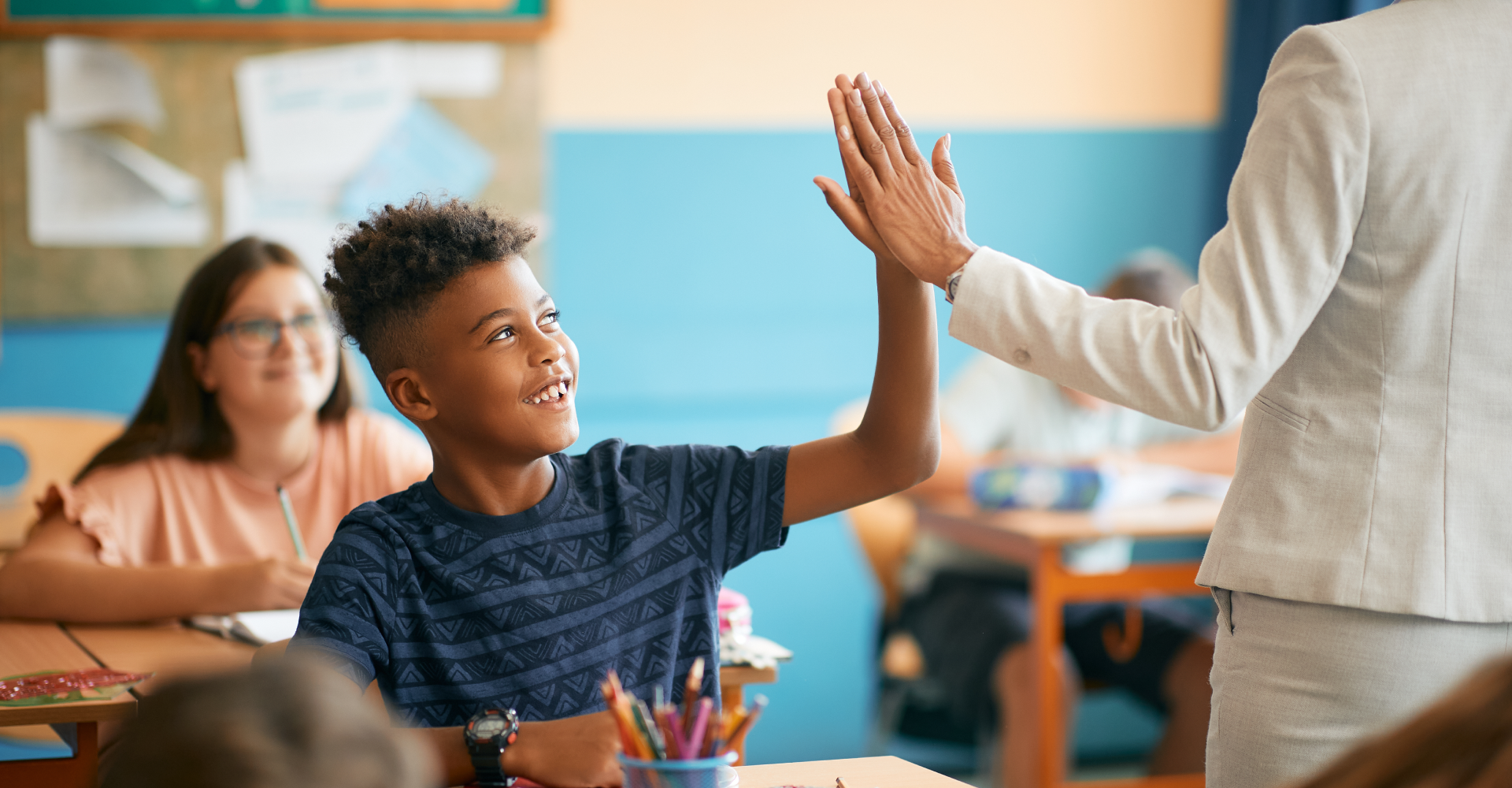Paul J. Bloomberg, Ed.D.
Isaac J. Wells
The Evolution of Teacher Collaboration
Educational collaboration in the United States has evolved significantly, particularly with the passage of the Every Student Succeeds Act (ESSA) in 2015, which replaced No Child Left Behind (NCLB). NCLB prioritized standardized test performance, creating an environment where teachers worked in isolation, focusing on compliance over creativity and collaboration. This approach negatively impacted both individual and collective teacher efficacy (Finnigan & Daly, 2013).
With ESSA’s shift toward a more holistic approach to education, greater emphasis has been placed on collaborative practices that promote equity, innovation, and learner agency. Professional learning communities (PLCs), as outlined by Dufour and Eaker (1998), became a cornerstone of this shift. Their research demonstrated how shared vision, collective responsibility, and a focus on results could transform schools into high-functioning learning organizations. By fostering structured collaboration, PLCs enable teachers to address challenges collectively and improve outcomes for all students.
Building on these principles, Gallimore and Ermeling’s (2010) work emphasized the importance of collaborative inquiry as the engine of effective teacher teams. Their research identified five keys to successful collaboration: structured agendas, clear protocols, the use of student evidence, ongoing reflection, and accountability for implementation. According to Gallimore and Ermeling (2010), collaborative inquiry allows educators to analyze student data, identify gaps, and design targeted interventions, fostering a culture of continuous improvement.
What Are Impact Teams?
Despite the advancements in collaborative models, a 2014 study by the Bill & Melinda Gates Foundation revealed persistent barriers, such as unclear goals, inconsistent protocols, and limited feedback mechanisms, which hindered the effectiveness of teacher collaboration. To address these challenges, the Impact Team Model integrates the foundational elements of PLCs and collaborative inquiry with a focus on advancing learner agency through equity-centered formative assessment practices (learning intentions and success criteria, self– and peer assessment, reflection, goal setting, etc.).
While both impact teams and professional learning communities (PLCs) focus on collaborative team practices, their approaches differ significantly. Impact teams are centered on student agency, collective efficacy, and culturally responsive assessment, emphasizing co-construction of success criteria and actionable feedback loops involving students. PLCs, on the other hand, often focus on analyzing data and aligning instructional practices among educators. Impact teams go beyond collaboration to actively engage students in the assessment for learning process and key influences that activate metacognition and self-regulation, making them co-creators of their educational journey.
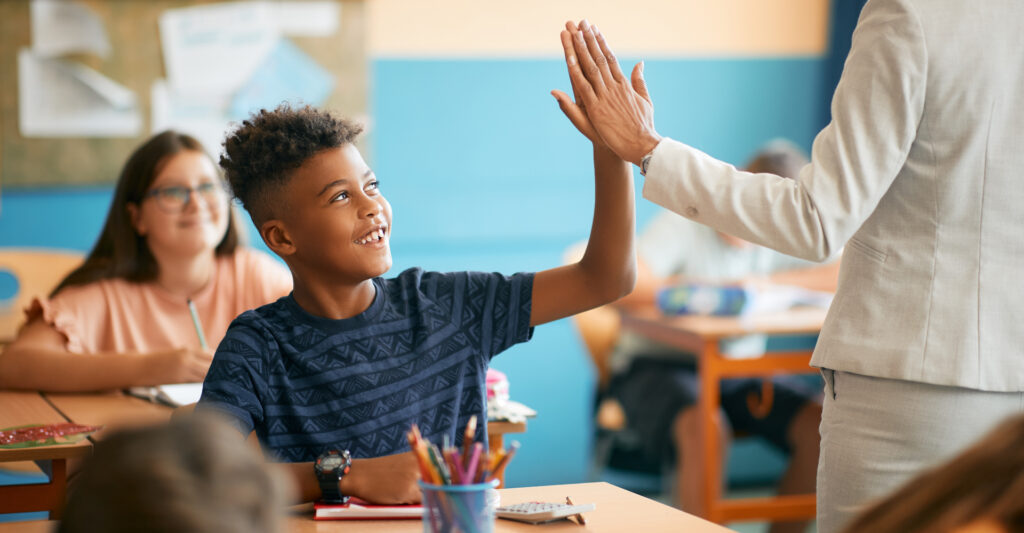
The Heart of the Impact Teams Model
Relational trust is at the heart of the Impact Team framework, strengthened by the incorporation of the Seven Circle Model developed by the National Equity Project. This framework recognizes that sustainable change is not solely driven by patterns, strategies, structures, or processes. While these operational elements are vital for fostering high-functioning collaboration, they are insufficient without the foundation of trust-based relationships. Prioritizing relationships, cultivating open information flow, and honoring identity are essential for grounding and sustaining equitable practices that lead to impactful and lasting change.
- Relationships: Building authentic relationships within impact teams and between educators, students, and families creates trust and emotional safety. These relationships are the foundation for meaningful collaboration and equity-centered practices. Without relational trust, operational strategies often fail to gain traction.
- Information: Information is like oxygen in a system. In its absence, people will “make it up” to keep moving forward. Access to information greatly minimizes negative rumors. When information is abundant, people focus on what is important and have greater security in knowing the priorities and what is happening across the organization.
- Identity: Recognizing and valuing the cultural identities and lived experiences of all stakeholders strengthens the connection to the shared mission of advancing learner agency. Identity informs how individuals engage with the work, creating a sense of belonging and purpose that drives sustained action.
When relationships, information flow, and identity are prioritized alongside operational elements such as patterns, structure, and process, impact teams are better equipped to enact and sustain systemic change. The Seven Circle Model emphasizes that equity must be woven into the fabric of collaborative efforts to ensure meaningful and lasting impact. This holistic approach ensures that collaboration is both high-functioning and impactful, driving sustainable change and measurable student success.
The Impact Teams EAA Protocol
The Evidence-Analysis-Action (EAA) Protocol is a structured framework within the Impact Team Model that guides educators through a collaborative process of examining evidence, analyzing root causes, and taking intentional action to improve teaching and learning. It fosters continuous improvement and helps professional learning communities address challenges in ways that are data-informed, equity-focused, and aligned with student needs.
The Impact Teams EAA Protocol Unpacked
1. Evidence: In this stage, impact teams collect, examine, and prioritize evidence related to student learning. Evidence can include student work samples, assessment data, classroom observations, and even student and family perception data. The focus is on understanding what the data say about student progress, strengths, and areas for growth. This step emphasizes using multiple sources of evidence to ensure a holistic view of the learning landscape.
Reflective Questions:
- What does the evidence tell us about our students’ learning?
- How are different groups of students performing?
- What patterns or trends emerge from the evidence?
2. Analysis: Impact teams collaboratively analyze the evidence to uncover the root causes of the identified challenges or gaps. This step goes beyond surface-level observations to explore systemic factors, instructional practices, and equity concerns that may be influencing outcomes. The analysis is framed through questions that challenge assumptions and invite reflection on the practices and policies affecting students.
Reflective Questions:
- What is contributing to these outcomes?
- How might our practices or systems be impacting student learning?
- What do students and families say about their experiences?
3. Action: The final stage focuses on designing and implementing actionable strategies to address the root causes identified during the analysis. Educators co-create solutions that are innovative, equity-centered, and responsive to student needs. This stage includes setting measurable goals, planning interventions, and continuously monitoring progress through iterative cycles of reflection and adjustment.
Reflective Questions:
- What actions will have the greatest impact on student learning?
- How can we involve students and families in the solution?
- How will we measure and monitor the effectiveness of our actions?
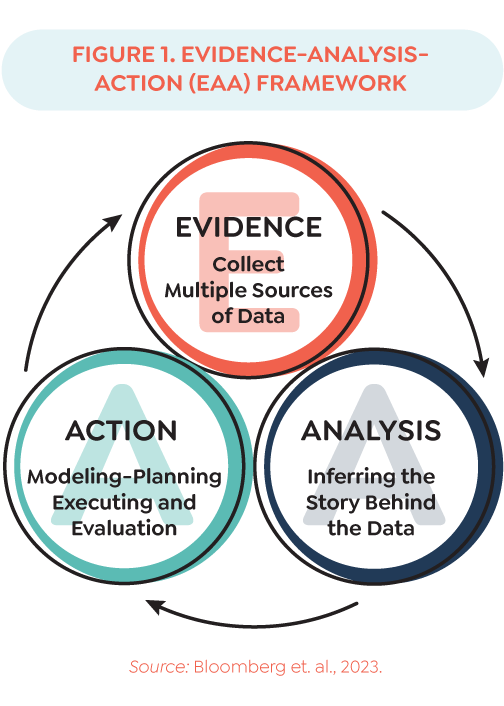
The EAA framework fosters shared ownership of student success and promotes a culture of continuous improvement. It enables teams to systematically approach challenges in a way that is reflective, data-driven, and grounded in the principles of equity and collaboration. Through this process, educators can move from simply identifying problems to creating sustainable solutions that support all learners, particularly those who have been historically underserved.
The Case for Human-Centered Design
A cornerstone of the Impact Team Model’s success is its emphasis on continuous improvement cycles within PLCs to tackle real-world challenges, or “puzzles of practice,” that educators encounter daily. Numerous case studies illustrate the positive impact of teacher collaborative inquiry and continuous improvement on educational outcomes. For example, a study conducted by Coburn and Turner (2011) demonstrated that schools implementing collaborative inquiry practices saw significant gains in student performance, particularly among marginalized groups. Similarly, the work of Hargreaves and Fullan (2012) emphasizes that schools characterized by collaborative cultures are more likely to sustain improvements over time.
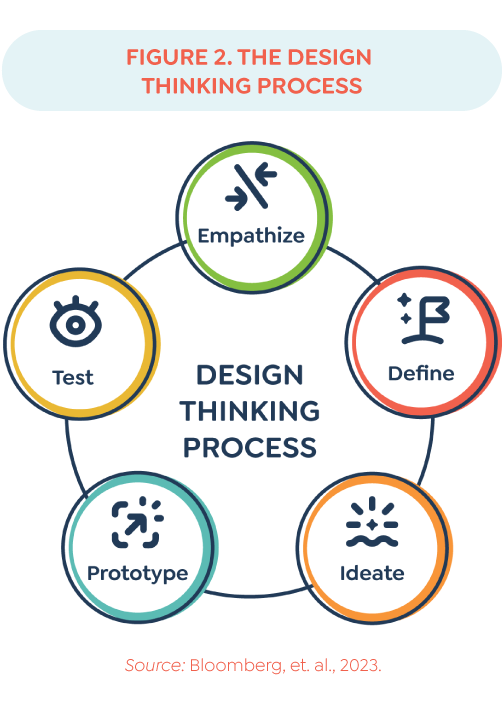
Empathy in Practice
Rooted in the principles of human-centered design, the Impact Team Model empowers educators to use empathetic methods and collaborative inquiry, to uncover the root causes of instructional challenges and systemic inequities. By amplifying the voices of underserved students and families, PLCs co-create innovative and equitable solutions, ensuring that the process of improvement is both inclusive and impactful. This cyclical approach fosters a culture of reflection, iteration, and shared ownership for student success.
Human-centered design begins with understanding the lived experiences of students and families. Through empathetic methods such as listening sessions, community focus groups, and classroom observations, educators can gain insights into the barriers faced by underserved populations. For example, by engaging multilingual learners and their families in discussions about their educational experiences, schools can better tailor instructional strategies to meet their needs.
Co-Creation for Lasting Impact
The design process thrives on the meaningful involvement of students, families, and educators as co-creators, acknowledging that diverse perspectives are key to designing solutions that resonate deeply with the community. This approach moves beyond traditional top-down decision-making by inviting the entire learning community to actively participate in identifying challenges, brainstorming solutions, and refining interventions.
By including students, schools can tap into the authentic experiences of those directly impacted by educational policies and practices. Their voices provide critical insights into what works and what doesn’t, ensuring solutions are relevant and student-centered. Families bring cultural wisdom and lived experiences that enrich the process, helping schools create interventions that are culturally responsive and inclusive. Educators contribute their expertise to pedagogy and classroom realities, ensuring that proposed solutions are feasible and aligned with instructional goals.
This collaborative process does more than create better solutions—it fosters trust among the learning community. When people see their voices valued and their ideas reflected in decisions, they develop a sense of ownership over the outcomes. This sense of collective ownership not only increases buy-in but also promotes sustainable change. Members of the community feel empowered to advocate for and maintain the solutions they helped create, leading to a greater likelihood of long-term success.
Ultimately, co-creation is not just about solving immediate problems; it’s about building a culture of partnership, equity, and mutual respect. By positioning students, families, and educators as equal collaborators, schools create a foundation for lasting impact that extends beyond any single intervention.
EAA and Human-Centered Design with Impact Teams
Within the framework of the Impact Team Model, human-centered design can be integrated at each stage of the Evidence-Analysis-Action (EAA) protocol to ensure solutions are both meaningful and sustainable. For example:
- Evidence: Collect qualitative data directly from students and families to supplement quantitative measures of learning.
- Analysis: Teams collaborate to examine patterns, prioritize challenges, and co-create hypotheses that reflect the unique dynamics of the school community.
- Action: Co-develop action plans with students and families, ensuring the solutions are feasible and meaningful.
Human-centered design principles can guide the prototyping of solutions through an iterative process that incorporates feedback loops, ensuring that interventions are continuously refined and tailored to meet the community’s needs. This integration fosters a culture of shared responsibility, amplifies the voices of the learning community, and ensures that actions are both inclusive and aligned with the goals of equity and agency. By embedding human-centered design into the EAA protocol, the impact teams not only solve puzzles of practice but also promote equity and inclusion in meaningful ways.
Amplifying Self-Efficacy
Self- and collective efficacy are the cornerstones of the Impact Team PLC model, anchoring its approach to continuous improvement. Self-efficacy, or an individual’s belief in their ability to impact student learning, empowers educators to take ownership of their practice. Within the Impact Team framework, educators engage in cycles of reflection and data analysis that build their confidence to design and implement high-impact strategies.
Research emphasizes that self-efficacy significantly influences teacher motivation, suggesting that principals can enhance teacher motivation by fostering self-efficacy through appropriate task assignments and strategies (Harun et al., 2020). Similarly, Kılıçoğlu’s research indicates that students with high self-efficacy are more motivated and likely to achieve academic success, reinforcing the notion that self-efficacy is a critical determinant of motivation in educational contexts (Kılıçoğlu, 2018). This relationship is further supported by Firmansyah and colleagues, who found a strong positive correlation between self-efficacy and student motivation, indicating that self-efficacy directly impacts academic achievement (Firmansyah et al., 2018). As educators see tangible progress in student outcomes linked to their efforts, their belief in their capacity to make a difference grows stronger. This individual confidence fuels a sense of agency and commitment to ongoing professional learning and improvement.
Self-Efficacy Unpacked
Self-efficacy—the belief in one’s ability to achieve goals—is foundational to success for students, families, teachers, principals, and district office leaders. The Impact Team Model fosters self-efficacy by leveraging four key sources: mastery moments, safety, feedback, and models of success. These sources are applied to all stakeholders through culturally responsive classroom protocols, leadership strategies, and system-wide practices that amplify learning and engagement.
To advance learner agency, students are placed in the driver’s seat of their education through assessment for learning practices. By co-constructing success criteria, engaging in self- and peer assessment, and reflecting on their progress, students actively shape their learning journey, fostering a sense of ownership and responsibility. At the same time, asset-based pedagogies are embedded into the model to recognize and celebrate the strengths, cultural identities, and lived experiences of all learners, ensuring equitable outcomes.
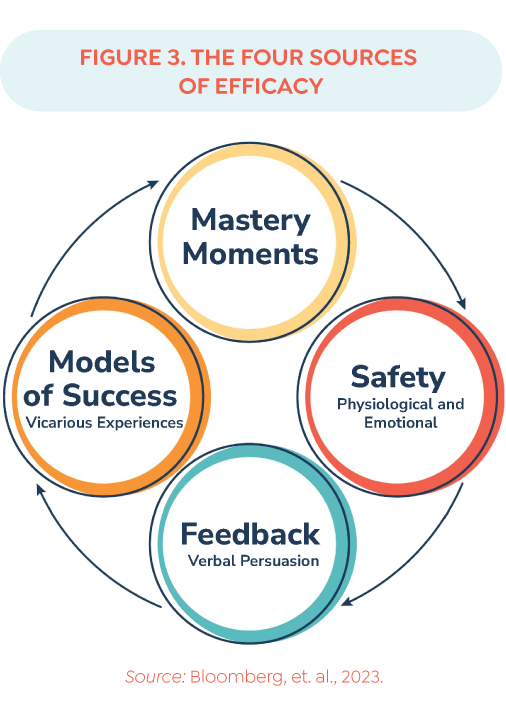
The Four Sources of Self-Efficacy
1. Mastery Experiences
- Students: Opportunities to reflect on successful learning experiences build confidence in their abilities to tackle challenges.
- Families: Engaging in shared successes, such as supporting student milestones, reinforces their role as essential contributors to growth.
- Teachers: Achieving instructional goals through collaborative inquiry strengthens their confidence in their ability to impact student outcomes.
- Principals and District Leaders: Successfully implementing school or district initiatives fosters a belief in their capacity to lead transformative change.
2. Safety
- Students: A supportive environment fosters risk-taking and learning from mistakes.
- Families: Feeling valued and respected by the school community ensures their continued engagement.
- Teachers: A culture of relational trust allows for honest dialogue, experimentation, and shared decision-making.
- Principals and District Leaders: Establishing trust across the system enables leaders to take calculated risks and innovate.
3. Verbal Persuasion and Feedback
- Students: Through our classroom protocols, students receive culturally responsive formative feedback, helping them refine their work and strengthen their understanding.
- Families: Regular, meaningful communication about their children’s progress builds trust and efficacy.
- Teachers: Peer and student feedback encourages teachers to continuously refine and improve their practices.
- Principals and District Leaders: Constructive feedback from staff and community stakeholders reinforces their leadership effectiveness.
4. Learning Vicariously via Models of Success
- Students: Observing peers who excel motivates them to adopt effective learning strategies or use exemplars for clarity.
- Families: Seeing other families positively impact school culture fosters belief in their ability to do the same.
- Teachers: Learning from exemplary teaching practices and strategies inspires confidence and professional growth.
- Principals and District Leaders: Witnessing schools successfully implement improvement efforts demonstrates how systemic change is achievable.
By anchoring these four sources in daily practice, the Impact Team Model ensures that self-efficacy is strengthened across all levels of the educational system, creating a foundation for sustained growth and success.
Strengthening Collective Efficacy
Equally vital is collective efficacy, the shared belief among educators that their collaborative actions can positively influence student achievement. Collective teacher efficacy (CTE) is a critical construct in educational psychology, reflecting teachers’ beliefs in their collective capabilities to influence student outcomes. It is grounded in the social cognitive theory proposed by Bandura, which emphasizes the importance of group-level efficacy beliefs in educational settings. According to Goddard et al., CTE is defined as “the teachers’ beliefs that the school as a whole can implement and organize courses of actions affecting students and their levels of attainments” (Goddard et al., 2000). This belief system is pivotal for enhancing student achievement and serves as a motivational force for teachers, fostering a collaborative environment that can lead to improved educational outcomes (Skaalvik & Skaalvik, 2019).
CTE and Student Achievement
The Impact Team PLC model emphasizes teamwork, transparency, and shared responsibility, fostering an environment where educators work together to solve challenges and celebrate successes. Through collaborative inquiry, goal setting, and evidence-based decision-making, teams build trust and a sense of purpose, creating momentum for sustainable change. Research has consistently demonstrated a positive correlation between CTE and student achievement. For instance, Goddard et al. found that “a one unit increase in collective teacher efficacy is associated with an increase of more than 40% of a standard deviation in student achievement” (Goddard et al., 2000).
This finding underscores the significant impact that teachers’ collective beliefs can have on educational performance. Similarly, Pierce highlights that “collective teacher efficacy research provides a direct link to student achievement,” suggesting that when teachers believe in their collective ability, students tend to perform better academically (Pierce, 2014). When PLCs adopt the Impact Team Model, they not only improve their practice but also cultivate a culture of collaboration, equity, and shared accountability. Together, self- and collective efficacy form the foundation for meaningful and lasting transformation in schools.
Collective Efficacy Unpacked
For collective teacher efficacy (CTE) to truly flourish and drive impactful outcomes, there must be clear and compelling evidence of success. Research by Donohoo, O’Leary, and Hattie (2020) underscores the critical role of CTE in influencing student achievement, defining it as the shared belief among educators in their collective ability to make a positive difference. However, this belief cannot exist in a vacuum—it thrives in environments where teachers see tangible evidence that their collaborative efforts are making a measurable impact.
When evidence of success is present, it validates teachers’ work, reinforcing their shared sense of efficacy and energizing their commitment to continuous improvement. This evidence might include improved student outcomes, data that reflect growth in learning, or observations of enhanced student engagement. Without such markers, sustaining the momentum of CTE becomes a challenge, as the shared belief that drives it depends on proof that collective action leads to real results.
To cultivate and sustain CTE, schools, and leaders must prioritize structures for gathering and sharing evidence of success. This could include creating opportunities for teachers to analyze data collaboratively, share stories of impact, and reflect on the practices that lead to improved outcomes. Evidence not only fuels efficacy but also strengthens the belief that, together, teachers can overcome challenges and achieve extraordinary results for their students.
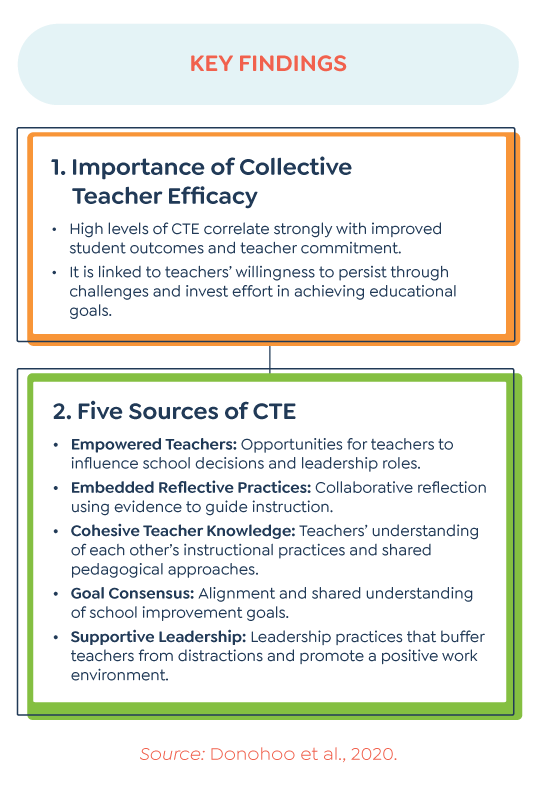 The Power of We
The Power of We
While self-efficacy is critical for individual growth, collective efficacy—the shared belief among members of a group that they can work together to produce meaningful outcomes—drives systemic change and school improvement. Research shows that collective teacher efficacy is one of the most influential factors in student achievement. When educators, families, and students believe in their collective ability to make a difference, the impact is profound.
The Impact Team Model fosters collective efficacy by embedding collaborative structures that enable teams to learn, reflect, and take action together. Through intentional cycles of inquiry, data-informed decision-making, and culturally responsive practices, schools create conditions where stakeholders trust in their shared ability to drive improvement. Impact teams integrate these conditions into school culture, ensuring that CTE is cultivated through intentional collaboration, reflection, and leadership support. The following list illustrates how students, families, teachers, and leaders partner together to support all five sources of collective teacher efficacy (Donohoo et al., 2020).
1. Empowered Teachers with Impact Teams
Opportunities for teachers to influence school decisions and leadership roles.
- Students: When students see their teachers engaged in decision-making and leading school initiatives, they recognize that educators have a voice and are invested in their success.
- Families: Parents trust schools where teachers are actively involved in shaping policies and practices that impact student learning.
- Teachers: When teachers have autonomy and influence over instructional decisions, professional learning, and school priorities, they feel more invested in their collective ability to make a difference.
- Principals and District Leaders: Effective leaders distribute leadership, ensuring that teachers have meaningful roles in shaping school improvement efforts.
2. Embedded Reflective Practices
Collaborative reflection using evidence to guide instruction.
- Students: When teachers engage in reflective practices, they refine instruction in ways that support student needs, making learning experiences more personalized and effective.
- Families: Families expect educators to use data and evidence-based reflection to make informed decisions about student learning.
- Teachers: Engaging in cycles of inquiry, examining student work, and reflecting on instructional strategies together builds confidence in their ability to improve student outcomes.
- Principals and District Leaders: Leaders cultivate a culture of continuous improvement by providing structures and time for teachers to reflect and apply learning in a collaborative setting.
3. Cohesive Teacher Knowledge with Impact Teams
Teachers’ understanding of each other’s instructional practices and shared pedagogical approaches.
- Students: Consistency in instructional approaches across classrooms provides students with a cohesive and equitable learning experience.
- Families: When educators align their practices, families see continuity in their child’s education and trust that teaching is intentional and coordinated.
- Teachers: Shared pedagogical approaches and knowledge of colleagues’ instructional practices strengthen professional trust and ensure that all teachers work toward common instructional goals.
- Principals and District Leaders: Leadership supports coherence by fostering professional learning communities (PLCs) and structures that allow teachers to learn from one another.
4. Goal Consensus
Alignment and shared understanding of school improvement goals.
- Students: Clearly defined learning goals create a sense of purpose and direction for students, helping them take ownership of their progress.
- Families: Families feel more engaged when they understand the school’s vision and see teachers working collaboratively toward common student achievement goals.
- Teachers: When educators share a collective commitment to school improvement goals, collaboration becomes more focused and purposeful.
- Principals and District Leaders: Leaders ensure that goals are transparent, aligned across grade levels, and reinforced through collaborative planning and decision-making processes.
5. Supportive Leadership with Impact Teams
Leadership practices that buffer teachers from distractions and promote a positive work environment.
- Students: When teachers feel supported, they are more engaged, creating a more positive and effective learning environment for students.
- Families: A strong leadership culture fosters trust in the school, reinforcing family-school partnerships.
- Teachers: Leaders who prioritize instructional time, reduce unnecessary administrative burdens, and provide resources enable teachers to focus on what matters most: student learning.
- Principals and District Leaders: Effective leaders cultivate trust, advocate for teacher needs, and create a culture where collective efficacy can flourish.
By integrating these five enabling conditions, the Impact Team Model ensures that educators work collaboratively, reflect critically, and lead with confidence—creating a school culture where collective efficacy drives meaningful student success.
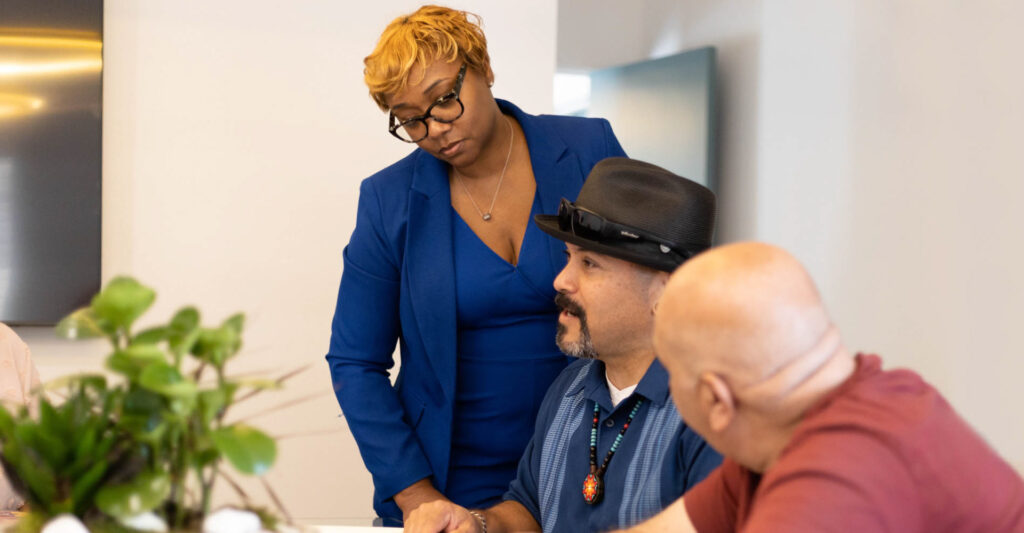
Purposeful Protocols Amplify Reflective Practices
The Impact Team Model is anchored in purposeful protocols that guide educators through structured, reflective practices and self-assessment to improve teaching and learning. As Guskey asserts, “Self-assessment can be a powerful technique for improving achievement” (Hinds & Berger, 2010). This statement underscores the potential of self-assessment as a tool that empowers educators to reflect on their practices and make informed adjustments that can lead to enhanced student performance. These protocols provide a clear framework for collaboration, ensuring that professional learning communities (PLCs) remain focused, equitable, and action-oriented. By design, Impact Team protocols help educators critically examine the evidence, engage in meaningful dialogue, and co-create solutions to advance student success.
The protocols are more than tools—they create a culture where reflection is a shared norm. By embedding reflection into every stage of the process, educators develop the habits of mind needed for continuous improvement. “When teachers engage in self-assessment, they not only evaluate their practices but also gain insights into their students’ learning needs” (Hinds & Berger, 2010). This highlights the dual benefit of self-assessment, where teachers can refine their instructional strategies while simultaneously addressing the diverse needs of their students.
Teams are encouraged to reflect on not only student outcomes but also their instructional strategies, equity practices, and the alignment of their work with shared goals. This collective reflection builds trust, enhances teacher efficacy, and fosters a growth mindset. Over time, educators learn to approach challenges as opportunities for growth, strengthening their ability to adapt and innovate in response to diverse student needs.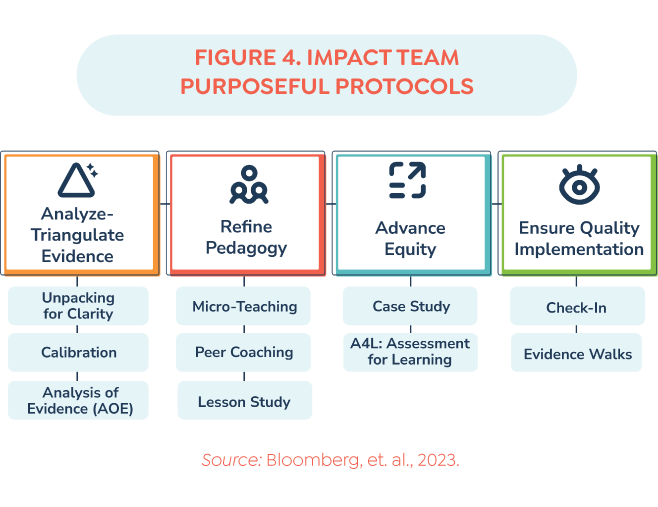 In essence, the purposeful protocols of the Impact Team Model serve as the foundation for reflective practices, transforming professional collaboration into a dynamic process of inquiry, learning, and improvement. These protocols ensure that reflection is systematic, actionable, and deeply connected to the goal of improving outcomes for all students.
In essence, the purposeful protocols of the Impact Team Model serve as the foundation for reflective practices, transforming professional collaboration into a dynamic process of inquiry, learning, and improvement. These protocols ensure that reflection is systematic, actionable, and deeply connected to the goal of improving outcomes for all students.
Impact Teams: Empowering Tiered Instruction with MTSS
The Impact Team MTSS (Multi-Tiered System of Supports) Model is a groundbreaking framework that integrates equity, transparency, and student agency into tiered instruction. Unlike traditional MTSS models, which often rely on top-down decision-making, the Impact Team MTSS Model places students at the center, empowering them to identify and advocate for the support they need to succeed. This transparent and student-driven approach ensures that interventions are personalized, culturally responsive, and effective across all tiers of instruction.

A Transparent Model for Tiered Support with Impact Teams
The Impact Team MTSS Model prioritizes clarity and collaboration among all stakeholders—students, teachers, families, and school leaders. Through structured protocols and transparent communication, students are actively involved in the process of identifying their strengths, challenges, and support needs. This approach not only builds student agency but also ensures that interventions are meaningful and aligned with individual learning goals.
How the Model Supports Tiered Instruction
The Impact Team MTSS Model is designed to provide equitable and scalable support across three tiers:
Tier 1: Universal Supports
In Tier 1, all students benefit from high-quality, culturally responsive instruction grounded in asset-based pedagogies. Teachers use formative assessment data to co-construct success criteria with students and guide them in self- and peer assessment. This proactive approach ensures that students have a clear understanding of their learning goals and the strategies needed to achieve them.
Tier 2: Targeted Supports
For students needing additional support, Tier 2 focuses on targeted interventions informed by both qualitative and quantitative data (including screener data). Students collaborate with teachers to analyze evidence of learning, identify specific areas for growth, and develop actionable plans. These interventions are designed to address skill gaps while maintaining high expectations and engagement. Impact teams determine if this support has an impact; they use a standard treatment protocol (STP). Teacher teams use pre/post-assessment to assess impact. Each formative cycle takes 3–4 weeks based on the cognitive demand of the standards being addressed. Reading foundation skills are typically progress monitored every 2 weeks.
Tier 3: Intensive Supports
In Tier 3, students with significant needs receive intensive, personalized support. The Impact Team MTSS Model ensures that these supports are co-designed with students and families, fostering a sense of ownership and partnership. By leveraging relational trust and culturally relevant practices, Tier 3 interventions build confidence and capacity for sustained success. Using a standard treatment protocol (STP), impact teams use pre- and post-assessments to determine the impact of this support.
Advancing Equity and Learner Agency with MTSS
The Impact Team MTSS Model is rooted in the belief that every student has the potential to succeed when provided with the right support. By empowering students to take an active role in the process, the model shifts the focus from deficits to strengths, ensuring that interventions are not only equitable but also affirming students’ cultural identities and lived experiences. This emphasis on transparency and collaboration creates a learning environment where students feel seen, valued, and capable of achieving their goals.
The integration of learner agency within the MTSS framework highlights the transformative potential of the Impact Team Model. By aligning tiered supports with equity-centered practices and fostering student ownership, this model provides a scalable and sustainable approach to improving outcomes for all learners.
Leverage Impact Teams for Your School
The Impact Team Model utilizes existing structures like team planning time to foster student-centered learning. By strengthening self- and collective efficacy and implementing human-centered design principles, impact teams empower educators and students alike to achieve sustainable innovation and growth. This learner-centered PLC model prioritizes collaborative inquiry and continuous reflection, allowing educators to co-construct success criteria, analyze evidence of student learning, and design actionable strategies that directly address their students’ needs.
The Impact Team Model champions culturally responsive strategies to advance learner agency, forging a collaborative culture where every student is empowered to succeed.
To learn more, visit www.LeadingImpactTeams.com.
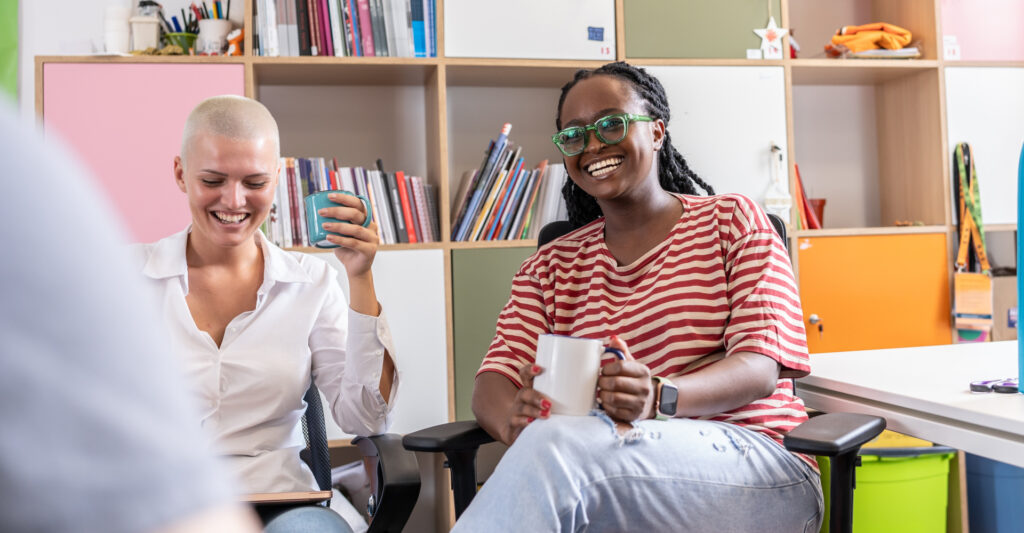
Our Impact: Case Studies
The heart of the Impact Team Model lies in its transformative ability to shift mindsets, foster collaboration, and elevate student achievement. Across the nation, educators have embraced this model to create meaningful changes in their classrooms, schools, and districts. By prioritizing student-centered practices, collaborative inquiry, and equity-driven approaches, impact teams have become a catalyst for reimagining teaching and learning.
This section showcases powerful case studies from schools and districts nationwide, celebrating how impact teams have redefined learner agency, enhanced teacher efficacy, and strengthened school communities. These impact stories serve as a testament to the model’s adaptability and potential to inspire sustainable, systemic change. Let these examples illuminate the possibilities, fuel your own practice, and remind us all of the shared mission to create equitable learning experiences for every student.
Mayo Elementary, SC
Dole Middle School, HI
Elgin Secondary Schools, OR
PS 78, NYC DOE
Petrides K-12, NYC DOE
PS 59, NYC DOE
Join Our Impact Team Learning Community
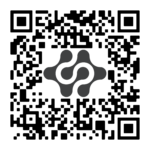
References:
Bloomberg, P., & Pitchford, B. (2023). Leading impact teams: Building a culture of efficacy and agency. Mimi and Todd Press.
Bloomberg, P., Vandas, K., Twyman, I., Dukes, V., Carrillo Fairchild, R., Hamilton, C., & Wells, I. (2022). Amplify learner voice through culturally responsive and sustaining assessment. Mimi and Todd Press.
Coburn, C. E., & Turner, E. (2011). Research–practice partnerships in education: Outcomes, dynamics, and future Directions. Educational Policy, 25(1), 1–30. https://doi.org/10.1177/0895904810380206.
Donohoo, J., O’Leary, T., & Hattie, J. (2020). The design and validation of the enabling conditions for the collective teacher efficacy scale (EC-CTES). Journal of Professional Capital and Community, 5(2), 1–21. https://doi.org/10.1108/JPCC-08-2019-0020
DuFour, R., & Eaker, R. (1998). Professional Learning Communities at Work: Best Practices for Enhancing Student Achievement. Bloomington, IN: National Educational Service.
Finnigan, K. S., & Daly, A. J. (2013). The role of social capital in the educational success of students: A review of the literature. Educational Research Review, 8, 1–15. https://doi.org/10.1016/j.edurev.2012.09.001
Firmansyah, F., Komala, R., & Rusdi, R. (2018). Self-efficacy and motivation: Improving biology learning outcomes of senior high school students. JPBI (Jurnal Pendidikan Biologi Indonesia), 4(3), 203–208. https://doi.org/10.22219/jpbi.v4i3.6878
Gallimore, R., & Ermeling, B. A. (2010, April 14). Five keys to effective teacher learning teams. Education Week.
Goddard, R. D., Hoy, W. K., & Hoy, A. W. (2000). Collective teacher efficacy: Its meaning, measure, and impact on student achievement. American Educational Research Journal, 37(2), 479–507. https://doi.org/10.3102/00028312037002479
Hargreaves, A., & Fullan, M. (2012). Professional capital: Transforming teaching in every school. Teachers College Press.
Harun, I. Y., Putrawan, I. M., & Miarsyah, M. (2020). Biological teachers’ motivation is based on personality and self-efficacy. International Journal of Engineering Technologies and Management Research, 6(6), 92–100. https://doi.org/10.29121/ijetmr.v6.i6.2019.397
Hinds, M. J., & Berger, M. J. (2010). Assessment of professional development by teachers and administrators: An examination of the literature in the context of one case study. McGill Journal of Education, 45(1), 81–92. https://doi.org/10.7202/1000031
Kılıçoğlu, G. (2018). Study on the relationship between social studies course self-efficacy and motivation levels of secondary school students. Universal Journal of Educational Research, 6(8), 1743–1748. https://doi.org/10.13189/ujer.2018.060816
Pierce, S. (2014). Examining the relationship between collective teacher efficacy and the emotional intelligence of elementary school principals. Journal of School Leadership, 24(2), 311–335. https://doi.org/10.1177/105268461402400204
Skaalvik, E. M., &Skaalvik, S. (2019). Teacher self-efficacy and collective teacher efficacy: Relations with perceived job resources and job demands, feeling of belonging, and teacher engagement. Creative Education, 10(07), 1400–1424. https://doi.org/10.4236/ce.2019.107104


